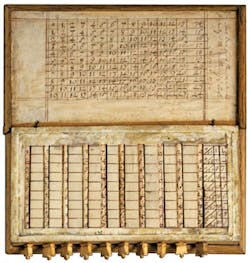There was a time not so long ago when calculators weren’t standard equipment for computations. The log() button did not exist, and some math had to be done by hand. John Napier and his logarithm simplified these tedious calculations. In 1614, he published Mirifici logarithmorum canonis descripto, which translates to A Description of the Wonderful Table of Logarithms. There are strikingly few books written about Napier, but from those that we have, we know that the Napiers of Merchiston were a noble, well-respected family and that John Napier did not have a day job, allowing him more time to focus on his studies.
Related Articles
- John Renshaw Carson: Pioneer Ruled Modulation's Earliest Innovations
- Irving Langmuir: Shining An Efficient Light On Surface Chemistry
- Edward Weston: A Dynamic Electrical Engineer
Napier is best known for logarithms and his “bones.” Although these two terms are often clumped together, they really have nothing to do with each other. While Napier’s bones are used for simple multiplication and division problems (made simpler by addition and subtraction), they could not be used to calculate large problems like logarithms can. After working on logarithms for 20 years, he published his book and has been known as their inventor ever since. However, there was quite an unknown competition during this time period that is rarely discussed. Not only is Napier the creator of a tool that has changed the life of engineers forever, he also had the cunning to ensure his idea was used.
This file type includes high resolution graphics and schematics when applicable.
Race To The Finish
John Napier was not alone in trying to find an easier way to accurately make calculations. During his time, astronomers were constantly making mistakes because of the large computations they had to perform. Joost Būrgi was one of these competitors. But Napier was smart, and he knew that it was important to get his work recognized. Publishing in English, printing his tables instead of handwriting them, and including a “user manual” with each book all made it easier to spread his ideas. Napier also was not afraid to take criticism, and he discussed how to improve his original system with Henry Briggs.
“Napier started his tables by saying […] that the beginning of the logarithmic values was 0 and it actually needed to be 1 to make the rest of the tables fall in line. So Briggs already had this idea, but Napier knew this was a problem,” said Dr. Kathleen Clark, associate professor in the School of Teacher Education at Florida State University.
Napier was so dedicated to his visits with Briggs that he actually died after one of his journeys. Būrgi, on the other hand, had a different set of responsibilities.
“Būrgi was employed by the royal court, the Habsburgs of Czechoslovakia, so he basically just went between his home country and Prague,” Clark said. Although Būrgi had similar ideas and was potentially working on them before Napier, he was not published until Napier’s text had been out for six years—thus the term logarithm had already been coined. So, would Būrgi’s method have been used if he had been of the same social standing as Napier?
“It is possible, although there are several other features of Napier’s work that made it popular; that it was immediately useful for the computation of sines, for instance, proved to be a huge advantage,” said Dr. Clemency Montelle, senior lecturer in the Department of Mathematics and Statistics at University of Canterbury. “Būrgi was at a royal court as well and had a few powerful friends.”
Although Napier had a social advantage, Būrgi seems to have had many connections as well and questions about whether or not Būrgi’s work would have been used more had he had this advantage seem irrelevant. Napier’s work was the best in the long run.
Logical Wit
It wasn’t all book smarts with Napier. He was also able to outwit many people. Mark Napier, a decedent of his, wrote in his Memoirs of John Napier of Merchiston about how John dealt with thieving servants: “Having missed some property, and suspecting his servants, he ordered them one by one into a dark room, where his favorite [rooster] was confined, and declared that the cock would crow when the guilty one stroked his back, as each was required to do. The cock remained silent during all the ceremony; but the hands of one of the servants were found to be entirely free from the soot with which the feathers of the mysterious bird had been anointed.”
Napier was a successful farmer as well, causing some to say he dabbled in alchemy.
“Evidently Napier spent a good deal of time going around dressed in a nightgown and cap. This led people to say that he was dressed as a warlock. Some biographies include the claim that Napier made a deal with the devil,” said Professor Michael J. Caulfield, professor of mathematics at Gannon University.
However, Napier did not need the devil’s help to make sure his crops were cared for. After warning a neighbor about his pigeons eating his crops, Napier threatened to catch the birds and keep them. The neighbor, not believing such a thing was possible, told Napier that if he could catch the birds then he could have them. The next morning the neighbor found Napier putting the birds into a sack. Napier had fed the birds brandy soaked peas, making them drunk and easy to obtain! This is just another example of one of the unorthodox ways Napier handled problematic situations.
First And Foremost, A Devout Protestant
John Napier’s commitment to the Protestant church may be overlooked due to his notable contributions in mathematics. However, Napier considered his work regarding the church, A Plaine Discovery of the Whole Revelation of St. John, to be his greatest achievement. He believed that if he was ever going to be known for something, this would be it.
Napier predicted that the world would end between 1688 and 1700, due to the belief that Pope Clement VIII was the Anti-Christ. At this time in the United Kingdom, the Catholic church—headed by Queen Mary—was trying to regain power over devout Protestants. Napier was very active in the movement against the queen. In addition to his writing, he set up artillery equipment that was meant to help the cause. One of these pieces includes the first modern-day tank, described as a vehicle covered in metal plates that men seated inside it drove. One of these inventions also included a mirror for burning enemy ships at any distance.
A driving force in Napier’s quest to protect Scotland and the Protestant religion may have been his father’s imprisonment by Queen Mary in 1571 after Napier returned home from studying abroad. “From the moment his mind began to work he aspired to be a Protestant champion and applied his whole energies to that sacred cause,” Mark Napier wrote in his Memoirs. Although there is little known about John Napier’s life as a religious man, his mathematical studies were only a hobby. He spent more of his time contributing to the controversial religious wars and tending to this castle.
Surviving Bones
Napier’s bones are his second most famous invention—behind logarithms, of course. But even though they are usually grouped together, Napier’s bones and logarithms have nothing to do with one another. “Napier’s bones was a device that would actually use lots of intermediate addition, instead of one large addition,” said Clark. They really are not suitable for trigonometry or any multiplication greater than 9.
While the bones are no longer considered useful, they were quite an innovation for the times—like a basic calculator. Napier’s bones are also known as Napier’s rods, which is a more accurate description. Before Napier’s tables could be mass produced and printed, his bones were physical rods, with the highest quality rods made out of ivory (which is why they are now called his bones).
The significance of his logarithms cannot be argued. Although the calculator also takes care of this function now, the logarithm greatly changed the lives of astronomers in Napier’s time.
“The logarithms developed by Napier allowed Johannes Kepler to more easily see the patterns hidden in Tycho Brahe’s data and thus to formulate Kepler’s three laws of planetary motion,” said Caulfield. “Later, Pierre-Simon Laplace, who lived in the late eighteenth and early nineteenth centuries, said that Napier ‘by shortening the labors doubled the life of the astronomer.’”
Influential Works By John Napier
• A Plaine Discovery of the Whole Revelation of St. John, 1593: outlining the problems with the Catholic church, portraying Pope Clement VIII as the Anti-Christ and predicting the end of the world
• Mirifici logarithmorum canonis descriptio (The Description of the Wonderful Canon of Logarithms), 1614: explained and provided 90 pages of tables for calculating logarithms
• Rabdologiæ seu Numerationis per Virgulas libri duo (Study of Divining Rods), 1617: outlined three devices to reduce timely arithmetic calculations—including Napier’s bones
• Mirifici logarithmorum canonis constructio (The Construction of the Wonderful Canon of Logarithms), 1619: Written before he Descripto but published after his death by his son Robert
• De Arte Logistica, 1839: An incomplete work on arithmetic and algebra, originally written in the early 1590s
About the Author
Sarah Mangiola
Sarah Mangiola has written on many different topics within Penton's Design, Engineering, and Sourcing Group. Originally from California, she graduated from the University of California, Davis with a B.A. in political science.


